Dr. Vadym Zayetsv.zayets(at)gmail.com |
|
 |
Dr. Vadym Zayetsv.zayets(at)gmail.com |
|
 |
more Chapters on this topic:IntroductionTransport Eqs.Spin Proximity/ Spin InjectionSpin DetectionBoltzmann Eqs.Band currentScattering currentMean-free pathCurrent near InterfaceOrdinary Hall effectAnomalous Hall effect, AMR effectSpin-Orbit interactionSpin Hall effectNon-local Spin DetectionLandau -Lifshitz equationExchange interactionsp-d exchange interactionCoercive fieldPerpendicular magnetic anisotropy (PMA)Voltage- controlled magnetism (VCMA effect)All-metal transistorSpin-orbit torque (SO torque)What is a hole?spin polarizationCharge accumulationMgO-based MTJMagneto-opticsSpin vs Orbital momentWhat is the Spin?model comparisonQuestions & AnswersEB nanotechnologyReticle 11
more Chapters on this topic:IntroductionTransport Eqs.Spin Proximity/ Spin InjectionSpin DetectionBoltzmann Eqs.Band currentScattering currentMean-free pathCurrent near InterfaceOrdinary Hall effectAnomalous Hall effect, AMR effectSpin-Orbit interactionSpin Hall effectNon-local Spin DetectionLandau -Lifshitz equationExchange interactionsp-d exchange interactionCoercive fieldPerpendicular magnetic anisotropy (PMA)Voltage- controlled magnetism (VCMA effect)All-metal transistorSpin-orbit torque (SO torque)What is a hole?spin polarizationCharge accumulationMgO-based MTJMagneto-opticsSpin vs Orbital momentWhat is the Spin?model comparisonQuestions & AnswersEB nanotechnologyReticle 11
more Chapters on this topic:IntroductionTransport Eqs.Spin Proximity/ Spin InjectionSpin DetectionBoltzmann Eqs.Band currentScattering currentMean-free pathCurrent near InterfaceOrdinary Hall effectAnomalous Hall effect, AMR effectSpin-Orbit interactionSpin Hall effectNon-local Spin DetectionLandau -Lifshitz equationExchange interactionsp-d exchange interactionCoercive fieldPerpendicular magnetic anisotropy (PMA)Voltage- controlled magnetism (VCMA effect)All-metal transistorSpin-orbit torque (SO torque)What is a hole?spin polarizationCharge accumulationMgO-based MTJMagneto-opticsSpin vs Orbital momentWhat is the Spin?model comparisonQuestions & AnswersEB nanotechnologyReticle 11
|
Spin Detection
Spin and Charge TransportThe Spin Detection is the effect of conversion of the spin accumulation into the charge accumulation in the electron gas of conduction electron . From a measurement of the built-up voltage due to the charge accumulation, the amount of the spin accumulation can be evaluated. The spin detection is used to measure the magnitude of the spin current.
|
A multimeter can not measure a spin accumulation! |
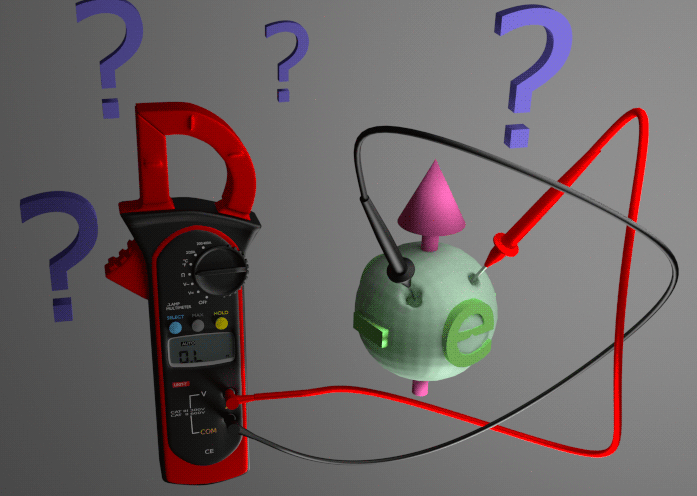 |
For the electrical measuring, the spin information must be converted into the charge information. This job of  |
A spin accumulation in an electron gas can be detected by measuring the magnetic field induced by the accumulated spins. However, this magnetic field is rather small and practically it is difficult to measure such a small magnetic field. The spin detection is an effect, which allows to measure a spin current and a spin accumulation electrically by measuring an electrical voltage.
1. Magnetic spin detection. ![]() Measurement of the magnetic field.
Measurement of the magnetic field.
This is a direct measurement. The measured magnetic moment is linearly proportional to the number of accumulated electrons.
Difficulties: 1) to achieve a spatial nanoscale resolution is difficult. 2) screening by the localized d- or f- electrons.
merit: direct measurements
2. Optical spin- detection. The measurement of absorption difference between left- and right- circular polarized light (MCD) or the Kerr rotation or the Faraday rotation.
The measurement of absorption difference between left- and right- circular polarized light (MCD) or the Kerr rotation or the Faraday rotation.
This is an indirect or near-direct measurement.
Even though the measured optical signal is proportional to the spin accumulation, the optical signal depends significantly on the band properties of a material.
Merit: spatial resolution of a few hundreds of nanometers (see Furis et. al (2017))
3. Electrical spin detection. The measurement of a voltage induced by the charge accumulated along the spin diffusion. This method is called the Spin Detection
This is an indirect measurement. The measured signal is proportional to the total charge, which is accumulated in the sample.
Demerit: indirect measurements, the measured signal is influenced by many factors.
Merit: simple experimental setup
Optical detection of spin accumulation and spin current |
| Measurement of spacial distribution of spin polarization in GaAs. Optical spin injection |
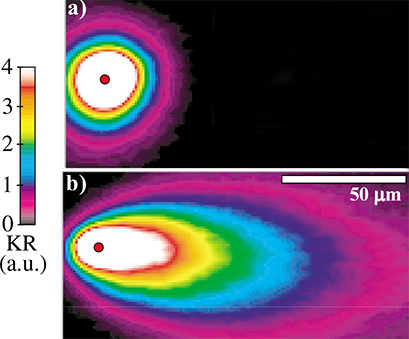 |
Spacial distribution of Kerr rotation angle in GaAs. Red circle shows the spot, at which focused circular polarized light excites spin-polarized electrons. The Kerr rotation angle is proportional to spin polarization sp of the conduction electrons. The spin polarization decays as the photo-excited electrons diffuse from the laser spot. (a) The electrical field is not applied. The spin polarization decays symmetrically in all directions. (b) Electrical field is applied ("+" at the right and "-" at the left). As the electrons are drifted along the electrical field, the spin polarization is drifted as well. |
S. A. Crooker and D. L. Smith, PRL 94, 236601 (2005). Permission |
| Click on image to enlarge it. |
Electrical spin detection. Two methods |
||||||
|
||||||
click on image to enlarge it |
![]() E.g. spin- polarized electrons (spin-up) are scattered more to the right than to the left. As a result, a charge is accumulated at the right side of the metallic wire, which can be detected by a pair of Hall electrodes.
E.g. spin- polarized electrons (spin-up) are scattered more to the right than to the left. As a result, a charge is accumulated at the right side of the metallic wire, which can be detected by a pair of Hall electrodes.
![]() The spin diffusion current is the sum of two opposite currents of spin- polarized and spin-unpolarized electrons. The flows are exactly the same, but opposite. When the conductivity is spin-independent, there is a balance between opposite electron flows and the spin diffusion current does not transform any charge. In contrast, when the conductivity is different for the spin-polarized and spin- unpolarized electrons, there is no balance and a different number of electrons flowing in opposite directions. As a result, a charge is accumulated along the flow of spin diffusion current and therefore an electrical voltage is built-up along the flow of the spin-current
The spin diffusion current is the sum of two opposite currents of spin- polarized and spin-unpolarized electrons. The flows are exactly the same, but opposite. When the conductivity is spin-independent, there is a balance between opposite electron flows and the spin diffusion current does not transform any charge. In contrast, when the conductivity is different for the spin-polarized and spin- unpolarized electrons, there is no balance and a different number of electrons flowing in opposite directions. As a result, a charge is accumulated along the flow of spin diffusion current and therefore an electrical voltage is built-up along the flow of the spin-current
Origin: ![]() (conventional- type detection): spin-dependent conductivity; (ISHE- type detection): spin- dependent scatterings
(conventional- type detection): spin-dependent conductivity; (ISHE- type detection): spin- dependent scatterings
Direction of electrical field build-up : ![]() (conventional- type detection): along the spin current; (ISHE- type detection): perpendicularly to the spin current
(conventional- type detection): along the spin current; (ISHE- type detection): perpendicularly to the spin current
Requirement for detection electrodes: ![]() (conventional- type detection): a special electrode with a strong spin- dependent conductivity should be used; (ISHE- type detection): no requirements. Any electrodes can be used
(conventional- type detection): a special electrode with a strong spin- dependent conductivity should be used; (ISHE- type detection): no requirements. Any electrodes can be used
material properties, which determine the spin detection efficiency: ![]() (conventional- type detection): spin-dependent conductivity if the detection electrode (MgO:Fe); (ISHE- type detection): Inverse Spin Hall effect (ISHE) in non-magnetic metal (Cu)
(conventional- type detection): spin-dependent conductivity if the detection electrode (MgO:Fe); (ISHE- type detection): Inverse Spin Hall effect (ISHE) in non-magnetic metal (Cu)
detection of spin accumulation or spin current : ![]() (conventional- type detection): spin accumulation; (ISHE- type detection): spin current
(conventional- type detection): spin accumulation; (ISHE- type detection): spin current
reliability, repeatability, controllability of the spin detection : ![]() (conventional- type detection): low/moderate; (ISHE- type detection): moderate/high
(conventional- type detection): low/moderate; (ISHE- type detection): moderate/high
 Conventional- type spin detection
Conventional- type spin detectionConventional Spin Detection |
 |
Conventional Spin Detection. Non-local configuration. Under the applied voltage, the charge current Jch (blue arrow) flow in the copper nanowire between two left electrodes. The conduction electrons in Fe are spin- polarized, therefore the spin-polarized electrons are injected and accumulated in Cu. In contrast to the charge current Jch (blue arrow), which can flow only along an electrical field, the spin current Jspin (red arrow) does require the electrical field and flows to the right. The he spin current Jspin (red arrow) is detected by the right MgO:Fe electrode. |
Physical mechanism of the conventional spin detection: |
| click on image to enlarge it |
Spin diffusion current is the flows of equal amounts of spin- polarized and spin-unpolarized electrons in opposite directions. Both flows transforms the charge, but the charge transfer in the opposite directions and exactly equal. The spin detection effect occurs in a material, in which the conductivities of spin- polarized and spin- unpolarized electrons are slightly different. As a result, the rate of moving electrons in one direction becomes faster than in the opposite direction. In order to establish a balance the charge is accumulated along the path of the spin current. The charge accumulation is decays along the propagation distance of the spin current. Due to the inhomogeneity of the charge accumulation, the electric field is created. The electrical field accelerates the current in one direction and slows down the current in the opposite direction. As a result, the electron flows in opposite directions become balanced.
![]()
![]()
![]()
![]() The conventional spin detection effect is described (is calculated ) by the detection conductivity σdetection, which is defined as a difference between conductivities of spin- polarized and spin- unpolarized electrons. See details here.
The conventional spin detection effect is described (is calculated ) by the detection conductivity σdetection, which is defined as a difference between conductivities of spin- polarized and spin- unpolarized electrons. See details here.

The coercive field (switching field) is different due to the difference of size of nucleation domains for the magnetization switching (or size and shape of static domains in the case of larger electrodes). The size of the nucleation domains depends on the shape, size, number of defects and shape imperfection in the ferromagnetic electrode (See details here).
The direction of spin polarization of injected conduction electrons is along the magnetization of Fe in the injection part. When the spin- polarized conduction electrons reach the detector, they diffuse into the bulk of Fe of the detector part and create a charge accumulation due to the spin- dependent conductivity in this part. The depth of their diffusion depends on direction of their spin- polarization with respect to the magnetization of Fe. When the spin polarization is along the spin polarization of Fe, the diffused spin- polarized electrons penetrate deeper into the bulk of Fe than in case the spin direction is opposite. As a result, the charge accumulation and therefore the detector voltage is different for the different mutual directions of spin- polarized electrons and the magnetization of Fe in detector part..
No. The dependence is non- linear. Only in the case of the ISHE- type of the spin detection, the detection voltage depends linearly on the spin polarization of the conduction electrons.
The MTJ is just an example, in which the spin detection effect is very strong. The bulk conductivity of a metal can be spin- dependent and therefore the conventional spin detection effect may occur in the bulk of metal.
strength: strong
(reason why the conductivity is spin- dependent) ![]()
![]()
![]() The tunneling is the spin- dependent process, which strongly dependent on the spin directions on states between which the electron is tunneling.
The tunneling is the spin- dependent process, which strongly dependent on the spin directions on states between which the electron is tunneling.
strength: weak/moderate
(reason why the conductivity is spin- dependent) ![]()
![]()
![]() The conductivity of a ferromagnetic metal may depend on spin direction of conduction electrons with respect to the spin direction of the localized d- electrons (See AMR effect and AHE effect). In this case the conductivity is different when spins of conduction electrons is along or opposite to the spins of the localized d- electrons (magnetization direction).
The conductivity of a ferromagnetic metal may depend on spin direction of conduction electrons with respect to the spin direction of the localized d- electrons (See AMR effect and AHE effect). In this case the conductivity is different when spins of conduction electrons is along or opposite to the spins of the localized d- electrons (magnetization direction).
strength: weak
(reason why the conductivity is spin- dependent) ![]()
![]()
![]() The
The
No. (at least from a simple view). The spin- dependent scatterings make more spin- up scattered into the left and more spin-down electrons to the left, but it does not makes the conductivity spin- dependent!
 Physical mechanism of Conventional- type Spin Detection Effect
Physical mechanism of Conventional- type Spin Detection Effect
Physical mechanism of the Conventional- type spin detection effect |
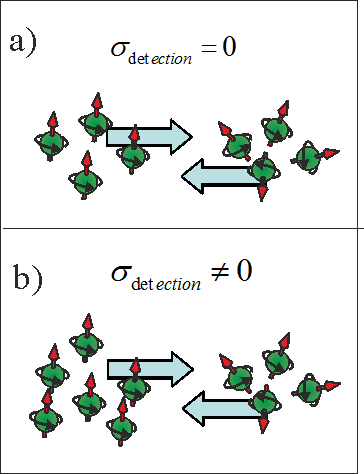 |
Fig.8. Spin diffusion current in material, which conductivity is (a) spin- dependent; (b) spin- dependent. |
| Note: Spin diffusion current is the flows of equal amounts of spin- polarized and spin-unpolarized electrons in opposite directions. The spin-polarized electrons diffuse from the region of a higher spin accumulation (on left side) to the region of a lower spin accumulation (on right side). The spin-unpolarized electrons diffuse in the opposite direction from right to left. |
| (a) case of a spin- independent conductivity. The conductivities of the spin- polarized and spin- unpolarized electrons are equal. The electrons moves from left to right and from right to left at same rate (speed). As a result, There is no charge accumulation. |
| (a) case of a spin- dependent conductivity. E.g. the conductivity of the spin-polarized electrons is larger than the conductivity of the spin-unpolarized electrons. As a result, the spin-polarized electrons move from left to right at faster rate than spin-unpolarized electrons move from right to left. This causes an increase of the number of electrons at the right side and therefore creates a charge accumulation. The electrical field of the accumulated charge accelerates electrons moving from right to left and slows down electrons moving from left to right. Therefore, the electrical field re- establish the balance of equal number of electrons moving in the opposite directions. |
(fact about spin diffusion current)![]() In the electron gas the charge and spin are transported by electrons. An electron has spin and charge and it transports both the charge and spin simultaneously. However, a current of electrons, which transports only spin but not the charge, is possible. It is the case when the spin- polarized electrons diffuse in one direction and exactly the same amount of the spin- unpolarized electrons diffuses in the opposite direction. When the spin-polarized and spin-unpolarized currents are the same, in total there is no charge diffusion, but there is a spin diffusion.
In the electron gas the charge and spin are transported by electrons. An electron has spin and charge and it transports both the charge and spin simultaneously. However, a current of electrons, which transports only spin but not the charge, is possible. It is the case when the spin- polarized electrons diffuse in one direction and exactly the same amount of the spin- unpolarized electrons diffuses in the opposite direction. When the spin-polarized and spin-unpolarized currents are the same, in total there is no charge diffusion, but there is a spin diffusion.
(normal case without the spin detection) Usually the conductivities of a metal is spin- independent. The conventional electron transport does not distinguish the electron spin. Some spin- dependent effect should influence the electron transport in order for the conductivity to become spin-dependent
![]() In this case, there is no charge accumulation along flow of a diffusion spin current. When the conductivity is spin- independent, equal amounts of spin- polarized and spin-unpolarized flow in opposite directions at the same rates and therefore there is no charge accumulation.
In this case, there is no charge accumulation along flow of a diffusion spin current. When the conductivity is spin- independent, equal amounts of spin- polarized and spin-unpolarized flow in opposite directions at the same rates and therefore there is no charge accumulation.
The charge accumulation is created at the moment when spin diffusion current starts to flow. Since the conductivities of the spin- polarized and spin- unpolarized electrons are slightly different, more electrons flow in one direction than in the opposite direction and the spin diffusion current is accompanied by a small charge current. The charge current builds up a charge accumulation, which induces an electrical field in the opposite direction to the flow of the charge current. The induced electrical field causes a charge current in the direction opposite to the direction of the charge current. The build up of the charge accumulation is stopped when the drift charge current becomes equal to the diffusion charge current and in total there is no charge current. By measuring the voltage induced by the build-up charge accumulation, the amount of spin current and the spin accumulation can be evaluated.
 Spin detection using Inverse Spin Hall effect (ISHE)
Spin detection using Inverse Spin Hall effect (ISHE)Spin Detection using ISHE |
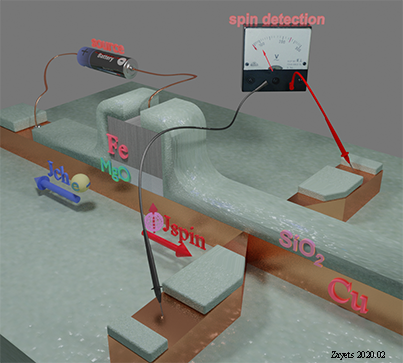 |
Fig.31. ISHE- type spin detection. Non-local configuration. Under the applied voltage, the charge current Jch (blue arrow) flow in the copper nanowire between two left electrodes. The conduction electrons in Fe are spin- polarized, therefore the spin-polarized electrons are injected and accumulated in Cu. In contrast to the charge current Jch (blue arrow), which can flow only along an electrical field, the charge current Jspin (red arrow) does require the electrical field and flows to the right. The spin current Jspin induces the Hall voltage due to ISHE effect, which is detected by the pair electrodes at right side |
| click on image to enlarge it |
![]() The effect of generation of charge current across a flow of a spin current is called the Inverse Spin Hall effect (ISHE).
The effect of generation of charge current across a flow of a spin current is called the Inverse Spin Hall effect (ISHE).
The spin flow is detected due to the spin- dependent scatterings. The conduction electrons with the same direction of the spin (spin- polarized electrons) are more scattered in one direction. As a result, an electron current (a charge current) flows in that direction. The charge current, which flows perpendicularly to the spin diffusion current, creates a charge accumulation at side of metallic wire, through which the spin diffusion current flows. The built- up voltage due to the charge accumulation is measured by a voltmeter and therefore the magnitude of the spin current is evaluated.
E.g. due to the spin- dependent scatterings more spin- up electrons are scattered towards the left and more spin-down electrons are scattered to the right. When the conduction electrons are not spin-polarized, the numbers of electrons scattered to the left and to the right are equal and therefore there is no electron current from the left to the right. When the electron gas is spin- polarized (e.g. spin- up polarized) and therefore there are more electrons with spin up, the more electrons are scattered towards the left than towards the right. As a result, the conduction from the right to the left.
![]()
![]()
 Origin of ISHE-type spin detection: spin- dependent scatterings (See here)
Origin of ISHE-type spin detection: spin- dependent scatterings (See here)
There are several different mechanisms, which cause a spin- dependent scattering in a material
![]()
![]() Mechanisms of ISHE-type spin detection:
Mechanisms of ISHE-type spin detection:
(mechanism 1): ![]() due to a non-zero orbital moment of conduction electrons; (mechanism 2):
due to a non-zero orbital moment of conduction electrons; (mechanism 2):![]() Skew scatterings (mechanism 3):
Skew scatterings (mechanism 3): ![]() Side-jump scatterings at defect(mechanism 4):
Side-jump scatterings at defect(mechanism 4):![]() Side-jump scatterings across an interface.
Side-jump scatterings across an interface.
Detection signal for Conventional Spin Detection |
||
|
||
Detection voltage vs external magnetic field. The detection signal is following the changes of the magnetization of spin-polarized conduction electrons and magnetization of Fe. |
||
(note): magnetic dependence of the detection signal are different for conventional and ISHE- type spin detections |
||
| click on image to enlarge it |
A. The spin current. A flow of an electron current is necessary condition for existence of the ISHE effect (See here)
The existence of the spin- depending scatterings is a more common property in a material than the existence of the spin- dependent conductivity. Therefore, The ISHE- type spin detection can be made inside of the studied material (just by detecting the Hall voltage by a pair of Hall probe). For example, when a spin diffusion current flows in a metallic wire, it creates a Hall voltage at the wire edges. In contrast, for the conventional spin detection, a material or an object having a high spin- dependence of the conductivity (e.g. a MgO- type tunnel barrier) is required. Therefore, the spin detector is fabricated separately and connected to studied material, in which the spin current flows. The magnitude of the spin accumulation at the entrance of the spin detector determines the detection signal.
 Physical mechanism of ISHE- type Spin Detection Effect
Physical mechanism of ISHE- type Spin Detection Effect
Physical mechanism of ISHE- type Spin Detection: Spin- Dependent scatterings |
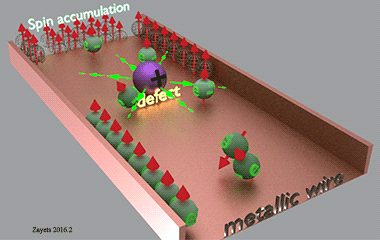 |
Fig. 30. Spin- dependent scatterings as the origin of the ISHE-type spin detection. E.g. spin- polarized electrons (spin-up) are scattered more to the right than to the left. As a result, a charge is accumulated at the right side of the metallic wire, which can be detected by a pair of Hall electrodes. |
| Spin-polarized conduction electrons flow from back-side to front-side. Spin-unpolarized electrons flow from front-side to back-side. Spin-polarized electrons are accumulated at left-side of wire. Spin-unpolarized electrons are not accumulated. |
| There is a region of spin accumulation at backside of the wire. The diffusive spin current flows from the region of a higher spin accumulation to the region of a lower spin accumulation. This means that spin polarized electrons flow from back to front of the wire. In the opposite direction the spin-unpolarized electrons flow. The scattering probability of spin-up electrons into the right is higher. This is the reason for the charge accumulation at the left side of the wire. |
| Figure shows the side- jump scatterings in the electrical field of a defect as an example. Any mechanism of spin-dependent scatterings contributes to the ISHE-type spin detection: mechanism 1, Skew scatterings (mechanism 2), side- jump scatterings (mechanism 4, mechanism 5) |
| click on image to enlarge it |
More details about Inverse Spin Hall effect is here
The following calculations is the calculation of the spin and charge transport in a metallic wire, which conductivity is spin- dependent.
The detection conductivity σdetection is defined as a difference between conductivities of spin- polarized and spin- unpolarized electrons. See details here.
σdetection is zero in the bulk of the metals and the semiconductors with a low density of defect
In a metal with defects, σdetection may become non-zero.
In the vicinity of an interface, σdetection may become non-zero .
σdetection measures a spin accumulation! |
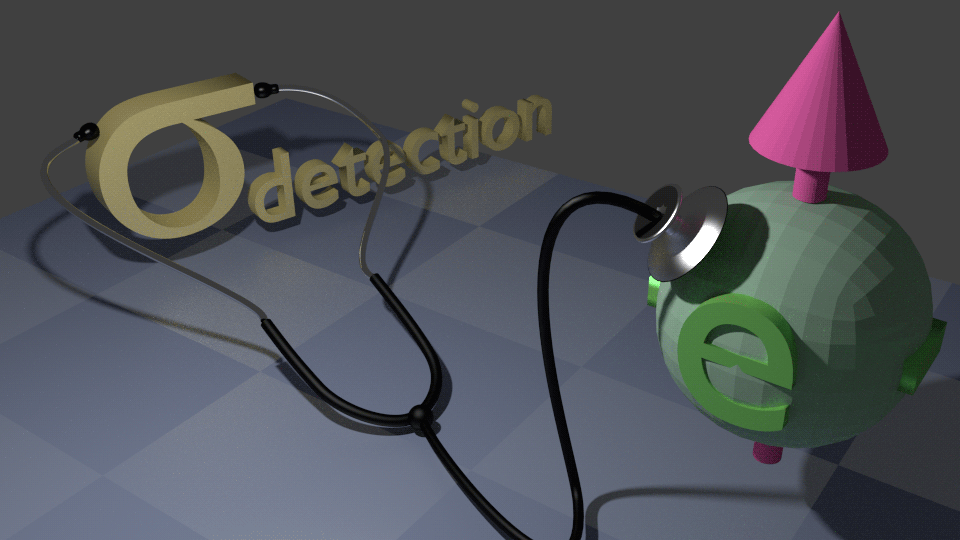 |
| When σdetection is non-zero, the charge is accumulated along a spin diffusion and the spin current can be detected. |
Approximation 1: case when σdetection is constant over all volume of a conductor
(It is a rough approximation. The detection conductivity is negligibly small in the bulk of a conductor and it becomes large in the vicinity of interface)
Dependence on spin diffusion length |
||||||
|
||||||
Fig. 9 (a) Spin polarization, charge accumulation and spin detection voltage in a metal wire. Animated parameter is the spin diffusion length. |
Comsol\Matlab calculation files are provided
Material parameters
Conductivity: 2E7 S/m Density of states at the Fermi energy: 2E22 1/cm^3/eV
Detection Conductivity: 0.9*Conductivity;;; Injection Conductivity: 0
Spin Conductivity: 1.15*Conductivity
Wire area: 0.01 um2; permittivity : 11.8
Matlab/Comsol calculation files
Comsol/ Matlab: SpinDetectionLine.m (Comsol only: SpinDetectionLine.mph) Matlab: SpinDetectionLineScan.m
Dependence on spin diffusion length |
||
|
||
.Fig.9. (right) accumulated charge and (left) detection voltage along a spin diffusion in a metal wire. Metals with different spin life time and spin diffusion length are shown. At zero distance the spin polarization sp equals 0.6 in all cases. |
Figure 9 shows the accumulate charge and the detection voltage along the spin diffusion in a non-magnetic wire. The cases of metals with different spin life times and spin diffusion lengths are shown. The diffusion starts at spin polarization sp=0.6, which corresponds in graphs to the zero diffusion distance. In metals with shorter spin life time the charge accumulation is larger at zero diffusion distance. Approximately one order shorter spin life time corresponds to one order larger charge accumulation. In contrast, the detection voltage does not depend on the spin life time. As can be seen from Fig. 9(b) the voltage between the point of the zero diffusion distance and a distant point is the same for metals of different spin life time. It should be noticed that in this case the detection voltage does not depend also on the drift current. Therefore, the detection voltage can be reliably used to detect the magnitude of a spin accumulation.
Dependence on a value and direction of drift current |
||||||
|
||||||
Fig. 10 Spin polarization, charge accumulation and spin detection voltage. Animated parameter is the value of the drift current flowing along the spin diffusion. |
Dependence on a value and direction of drift current |
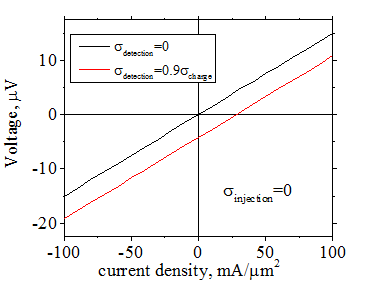 |
Fig. 11. IV characteristic of a conductor, in which the detection conductivity is zero (black line) and non-zero (red line).
|
There is a charge accumulation, but the resistance does not dependent of the spin polarization
Figure 11 shows the IV characteristic of a conductor, in which the detection conductivity is zero (black line) and non-zero (red line).
There is an offset between lines, because of the charge accumulation.
However, lines are parallel. This means the resistivity is the same in both cases and there is no magneto-resistance.
"Dirty" Spin Current |
 |
(fact 1) There is no "pure" spin current or "dirty" spin current. (fact 2) There is a drift current, which may be spin-polarized. A drift current flows along an electrical field (fact 3) There is a spin diffusion current, which may have a charge component and along which a charge may be accumulated (case when σdetection ≠0). The diffusion spin current flows from a region of a higher spin accumulation to a region of a lower spin accumulation (but not along the electrical field) |
At present,the term "pure" spin current is often used in order to describe a diffusion spin current, which is define as a spin current without flow of the charge
there are two possibility of "unpurity" of the spin current
(possibility 1 of "unpurity" of spin current) ![]() (Spin Flow + Charge Flow): a drift spin- polarized current, which flows along an electrical field. It is a flow of spin- polarized and spin-unpolarized conduction electrons. Spin Flow + Charge Flow.
(Spin Flow + Charge Flow): a drift spin- polarized current, which flows along an electrical field. It is a flow of spin- polarized and spin-unpolarized conduction electrons. Spin Flow + Charge Flow.
(possibility 2 of "unpurity" of spin current) ![]() (Spin Flow + Charge Accumulation) a diffusion spin current accompanied by a charge accumulation. This spin current flows between regions of a higher and lower spin polarization (but not along an electrical field) in a material, in which the bulk conductivity is spin- dependent σdetection ≠0 , and therefore in which a spin current is always accompanied by a charge current.
(Spin Flow + Charge Accumulation) a diffusion spin current accompanied by a charge accumulation. This spin current flows between regions of a higher and lower spin polarization (but not along an electrical field) in a material, in which the bulk conductivity is spin- dependent σdetection ≠0 , and therefore in which a spin current is always accompanied by a charge current.
A charge current needs a source and drain. A spin current needs only a source. (For details See here). Even if a spin diffusion current is accompanied by a diffusion charge current (The case when σdetection ≠0 ), a charge is accumulated along diffusion. It induces the current in the opposite direction. It causes that the net charge current becomes zero along the spin diffusion. As a result, still the spin diffusion current is pure.
I will try to answer your questions as soon as possible